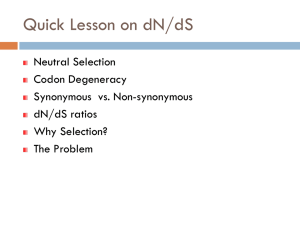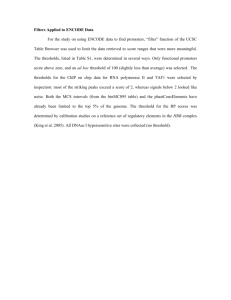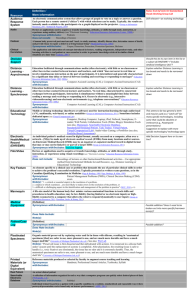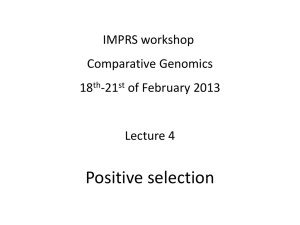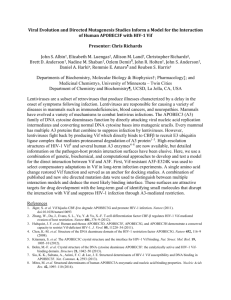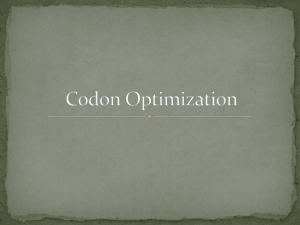Hi my name is Itay and I will present a study that is a joint work with
advertisement
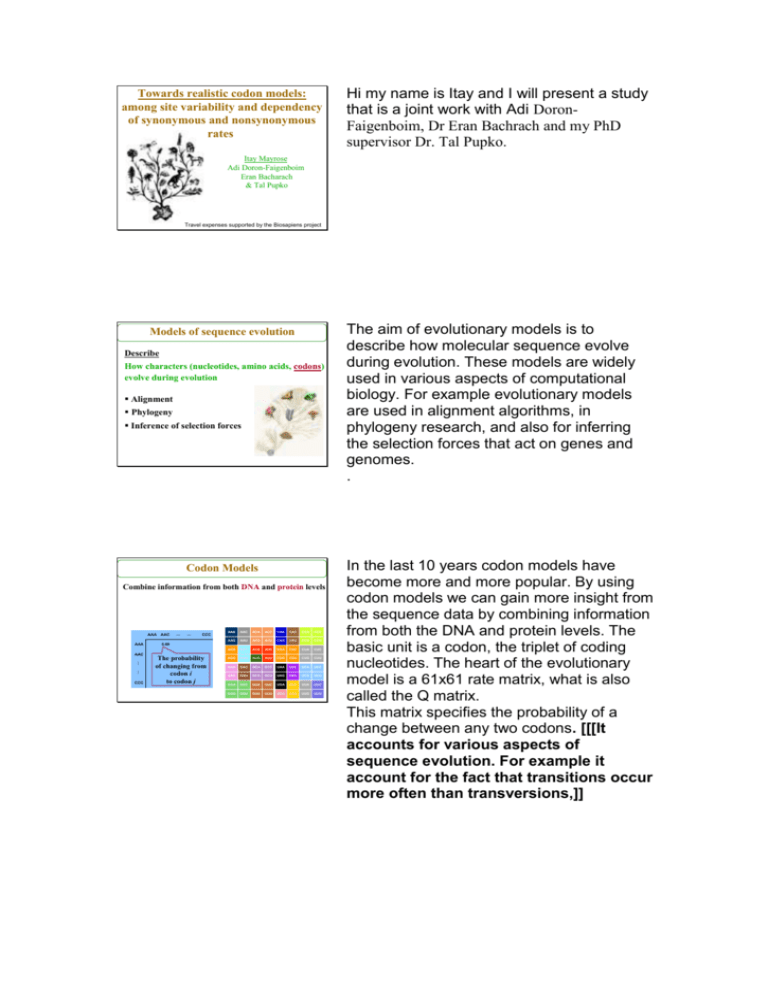
Towards realistic codon models: among site variability and dependency of synonymous and nonsynonymous rates Hi my name is Itay and I will present a study that is a joint work with Adi DoronFaigenboim, Dr Eran Bachrach and my PhD supervisor Dr. Tal Pupko. Itay Mayrose Adi Doron-Faigenboim Eran Bacharach & Tal Pupko Travel expenses supported by the Biosapiens project Models of sequence evolution Describe How characters (nucleotides, amino acids, codons) evolve during evolution Alignment Phylogeny Inference of selection forces Codon Models Combine information from both DNA and protein levels AAA AAA AAC … … CCC AAC … … CCC AAC ACA ACC CAA CAC CCA CCC AAG AAU ACG ACU CAG CAU CCG CCU AGA AAA AGC AUA AUC CGA CGC CUA CUC AGG AGU AUG AUU CGG CGU CUG CUU GAA GAC GCA GCC UAA UAC UCA UCC GAG GAU GCG GCU UAG UAU UCG UCU GGA GGC GUA GUC UGA UGC UUA UUC GGG GGU GUG GUU UGG UGU UUG UUU 0.09 The probability of changing from codon i to codon j The aim of evolutionary models is to describe how molecular sequence evolve during evolution. These models are widely used in various aspects of computational biology. For example evolutionary models are used in alignment algorithms, in phylogeny research, and also for inferring the selection forces that act on genes and genomes. . In the last 10 years codon models have become more and more popular. By using codon models we can gain more insight from the sequence data by combining information from both the DNA and protein levels. The basic unit is a codon, the triplet of coding nucleotides. The heart of the evolutionary model is a 61x61 rate matrix, what is also called the Q matrix. This matrix specifies the probability of a change between any two codons. [[[It accounts for various aspects of sequence evolution. For example it account for the fact that transitions occur more often than transversions,]] Codon Models Combine information from both DNA and protein levels Synonymous (silent ) Non-synonymous (amino-acid altering) AAA AAA AAC … … CCC AAC … … CCC AAC ACA ACC CAA CAC CCA CCC AAG AAU ACG ACU CAG CAU CCG CCU AGA AAA AGC AUA AUC CGA CGC CUA CUC AGG AGU AUG AUU CGG CGU CUG CUU GAA GAC GCA GCC UAA UAC UCA UCC GAG GAU GCG GCU UAG UAU UCG UCU GGA GGC GUA GUC UGA UGC UUA UUC GGG GGU GUG GUU UGG UGU UUG UUU 0.09 The probability of changing from codon i to codon j Codon Models Combine information from both DNA and protein levels Synonymous (silent ) Non-synonymous (amino-acid altering) AAA Purifying evolution Neutral evolution Positive Darwinian evolution AAC ACA ACC CAA CAC CCA CCC AAG AAU ACG ACU CAG CAU CCG CCU AGA AGC AUA AUC CGA CGC CUA CUC AGG AGU AUG AUU CGG CGU CUG CUU GAA GAC GCA GCC UAA UAC UCA UCC GAG GAU GCG GCU UAG UAU UCG UCU GGA GGC GUA GUC UGA UGC UUA UUC GGG GGU GUG GUU UGG UGU UUG UUU Detecting selection pressure S1 AAG ACT GCC GGG CGT ATT S2 AAA ACA GCA GGA CGA ATC S1 K T A G R I S2 K T A G R I Synonymous = 6 Non-synonymous = 0 Purifying selection: Non-synonymous << Synonymous substitutions Histones But the most important use of codon models is that now [[using this matrix]] we can differentiate between two kinds of substitution rates: the synonymous, or silent, substitution rate, are those between two codons that do not change the amino acid. Usually these are substitutions at the third position of the codon. In addition, we get the non-synonymous rate, substitutions that cause a change in the coded amino-acid. By contrasting these two types of rates we can infer not only if a protein position is conserved, under purifying selection, or variable, under no selection, but also and what is unique to codon models is the inference of positive adaptive evolution. So, for example, if one observes that all substitutions in a gene are silent – here 6 substitutions are synonymous and zero nonsynonymous, so the encoded protein is completely conserved. This means that the protein is under strong purifying selection. The most known example is the histone family where there is very strong purifying selection at the protein level. And indeed all observed substitutions are silent. Detecting selection pressure S1 AAG ACT GCC GGG CGT ATT S2 AAA ACA GAC GGA CAT ATG S1 K T A G R I S2 K T D G H M Synonymous = 3 Non-synonymous = 3 Neutral selection: Non-synonymous = Synonymous substitutions Detecting selection pressure S1 AAG ACT GCC GGG CGT ATT S2 AAT ATT GAC GAG CAT ATG S1 K T A G R I S2 N I D E H M Synonymous = 0 Non-synonymous = 6 Positive (Darwinian) selection : Non-synonymous >> Synonymous substitutions Host-pathogen arm-race The Ka/Ks ratio Synonymous substitution rate Non-synonymous substitution rate Assume: Ks = neutral rate of evolution Ka/Ks < 1Purifying selection: Ka/Ks = 1Neutral selection: Ka/Ks > 1Positive selection: In some cases the rates of nonsynonymous and non-synonymous substitutions are equal. In this case, we assume that the synonymous substitution rate corresponds to the neutral rate of evolution and so the protein is under neutral evolution or no selection. In exceptional cases, almost all observed nucleotide substitutions change also the coded amino acids, so the number of nonsynonymous substitutions is significantly higher than the number of synonymous substitutions. This is indicative for a situation where it is beneficial for a protein to change and may point to a protein that is under positive selection. For example, it was found that positive selection operates in proteins involved in host-pathogen arm-race. HIV is a classical example, where certain positions are under positive selection, which allows the virus to escape the host immune system. Formally, the synonymous substitution rate is termed Ks and the non-synonymous rate is termed Ka. If we assume that Ks represents the neutral evolutionary rate then we compute the Ka/Ks rate ratio and infer the type of selection. So purifying selection is inferred when the KaKs rate ratio is significantly lower than 1. And positive selection is inferred when this ratio is significantly higher than 1. Existing codon models Assume: Ka varies over sites Ks is the same for all sites and reflects the neutral rate of evolution •Goldman & Yang (1994) •Muse & Gaut (1994) Almost all existing codon evolutionary models assume that the Ka rate can vary between sites due to selection at the protein level. In contrast, these models assume that there is no selection at the DNA level and so the synonymous rate is the same for all sites. •Nielsen & Yang (1998) •Wong, Sainudiin & Nielsen (2006) •Doron-Faigenboim & Pupko (2007) Existing codon models Assume: I will call this model KaV-KsC for variable Ka and constant Ks. Ka varies over sites Ks is the same for all sites and reflects the neutral rate of evolution Model name: KaV-KsC •Goldman & Yang (1994) •Muse & Gaut (1994) •Nielsen & Yang (1998) •Wong, Sainudiin & Nielsen (2006) •Doron-Faigenboim & Pupko (2007) Existing codon models Assume: Ka varies over sites Ks is the same for all sites and reflects the neutral rate of evolution Ks constant? •Goldman & Yang (1994) •Muse & Gaut (1994) •Nielsen & Yang (1998) •Wong, Sainudiin & Nielsen (2006) •Doron-Faigenboim & Pupko (2007) The question is if this assumption, which states that the Ks is the same for all positions, is valid and truly represents the biological reality. There are several indications that this is not the case. Existing codon models Assume: Ka varies over sites Ks is the same for all sites and reflects the neutral rate of evolution For example, the group of Svante Paabo have estimated that around 40% of synonymous sites in primates are subject to purifying selection Ks constant? Hellmann et al. (2003): Approximately 39% of synonymous sites in primates are subject to purifying selection Selection against silent substitutions Human Mouse Dog GAG GCT GCC GGG CGT ATT GGC ACT GCC GGG CGT ATT GGG ACT GCC GGG CGT ATT RNA stability Exonic splicing regulatory sequences RNA editing Overlapping genes Codon bias and GC content Translational efficiency Protein folding Reviewed in Chamary, Parmley, and Hurst Nature Reviews Genetics (2006) Evolutionary models for Ks conservation Pond & Muse: both Ka and Ks can vary (two independent gamma distributions) Model name: KaV-KsV Pond and Muse Mol Biol Evol (2005) “Site-to-site variation of synonymous substitution rates” Conservation of synonymous sites may result from various kinds of selection pressure. For example, in the mRNA, there are some sites, especially those in the stem regions, that are important for maintaining the RNA stability. There are of course other kinds of selection: splicing regulatory elements, RNA editing, overlapping genes, codon bias, translation efficiency. And even few months ago it was shown that a synonymous substitution change the rate of translation and results in a protein with a completely different 3D structure. A main challenge is how to capture the selection on synonymous sites within the evolutionary model. Recently Pond & Muse have presented an evolutionary model in which both the Ka and Ks rates can vary over sites. Technically they assumed that the Ka and ks rates are sampled from two independent rate distributions. I will call this model KaV-KsV as both Ka and Ks can vary between sites. Evolutionary models for Ks conservation The KaV-KsV model assumes: Each position evolves independently But: • Selection is often regional • Site-specific Ka and Ks are very erratic 4 3.5 3 2.5 2 1.5 1 0.5 0 50 100 150 200 Evolutionary models for Ks conservation The KaV-KsV model assumes: Each position evolves independently But: • Selection is often regional • Site-specific Ka and Ks are very erratic 4 3.5 Ka True Ks 3 2.5 Ka/Ks 1.0 1.0 2 1.0 Estimated 1.2 1.5 0.8 1.5 Similar to most evolutionary models, this model assumes that each site along a sequence evolves independently. But selection forces, especially those that influence synonymous sites, are often regional. In addition, because the estimated Ka/Ks values are now a ratio of two inferred quantities, inference inaccuracies can quickly lead to very erratic estimates. For example: let’s say that we are looking at a neutrally evolving site with both Ka and Ks equal 1. Random fluctuations in the sequences can easily shift the inference of Ka to be 1.2 and the inference of Ks to 0.8. The inferred ka/ks ratio for this site will be 1.5 which is a signature of positive selection. 1 0.5 0 50 100 150 200 Evolutionary models for Ks conservation The KaV-KsV model assumes: Each position evolves independently But: • Selection is often regional • Site-specific Ka and Ks are very erratic 4 Our solution: 3.5 3 Incorporate site-dependencies 2.5 2 1.5 1 0.5 0 50 100 150 200 So how can we solve this erratic behavior? One option is to use a sliding window approach to smooth the inferred rates. But a more statistically robust approach is to incorporate the biological phenomena that adjacent positions have similar rates into the evolutionary model. Modeling dependencies among sites Ka at position n depends on the Ka at position n-1 & Ks at position n depends on the Ks at position n-1 Two HMM chains Ka 0.1 0.3 0.8 0.7 0.2 Ks 1.3 0.8 1.0 0.7 0.1 TCA TCC TAC GCC GCG GCC ATC ATC ATC Hidden states CTT CTA CTG Observations GGG GGG GAA Modeling dependencies among sites Ka at position n depends on the Ka at position n-1 & Ks at position n depends on the Ks at position n-1 So in our suggested model the Ka at position n depends on the Ka at position n-1 & similarly for Ks. This dependency is incorporated into the model by assuming two hidden markov models, or HMMs. One represents the variation of Ka along the sequence and the other the variation of ks. So now, if the Ka rate at the first position is 0.1 then there is a higher chance that position 2 will have a similar Ka rate. The technical details of the model are presented in the paper, so I won’t cover them here. We call this model KaD-KsD as both rates are dependent among adjacent positions. Model name: KaD-KsD Two HMM chains Ka 0.1 0.3 0.8 0.7 0.2 Ks 1.3 0.8 1.0 0.7 0.1 TCA TCC TAC GCC GCG GCC ATC ATC ATC Hidden states CTT CTA CTG Observations GGG GGG GAA Comparing the models Models tested • KaV-KsC: Variable nonsynonymous Constant synonymous • KaV-KsV: Variable nonsynonymous Variable synonymous • KaD-KsD: Dependent nonsynonymous Dependent synonymous So to summarize, we want to compare between 3 models: the first which is the most simple and also the most widely used ignores the possibility of Ks variation. The second assumes that both the Ka and Ks rates can vary. This model ignores the spatial correlation of rates. And finally our model, which accounts for both dependency and variability of the Ka and Ks rates. To compare these 3 models we have analyzed the 9 coding genes of HIV-1. We chose HIV because it is a well known example to have sites evolving under positive selection. Also in viruses, because of their compact genome we expect to find more selection at the DNA level. For each gene of HIV-1 multiple sequence alignment were downloaded from the Los Alamos HIV database. For each dataset a phylogenetic tree was created. And then the parameters of each model were optimized until convergence of the likelihood function. Using the likelihood ratio test we then tested if the increase in likelihood is statistically justified when moving from the simple to the more complex ones. Comparing the models For each of the 9 coding genes of HIV-1: Multiple sequence alignment Phylogenetic tree Parameters optimization Model comparison (LRT) HIV-1 data Accounting for Ks variability is extremely justified for all HIV-1 genes HIV-1 genes exhibit a strong pattern of rate dependency HIV-1 gene Log-likelihood difference from KaV-KsC KaV−KsV KaD−KsD env 914 1080 gag 362 nef 339 380 pol 1346 1565 rev 228 248 tat 214 228 vif 239 279 vpr 130 154 vpu 188 197 409 Difference of 5 log-likelihoods is significant (p < 0.01) This table shows the difference in loglikelihood for each gene compared between the constant ks model and the two models that allow for Ks variation. Difference of 5 log-likelihood points between the models is considered significant. As you can see the differences in loglikelihoods between the models for all HIV-1 genes is very high, in the order of hundreds. So it is clear that accounting for Ks variability is extremely well supported. In addition, accounting for the dependencies between adjacent Ka and Ks rates is also highly justified. Now, the comparison between log-likelihood values tells which model is best supported by each gene but it doesn’t tell us if we can gain more biological insights when using a more complex model. So the question is “does it really matter which model to use?” Inferring sites under positive selection KaV-KsC 491 KaV-KsV 295 41 66 310 135 53 5 13 1. The most conservative 2. With the highest overlap with the other models KaD-KsD 206 True positive rate Inferring sites under positive selection KaV-KsV KaD-KsD 0.8 0.6 0.4 KaV-KsC 0.2 0 0 0.1 0.2 False positive rate 0.3 One of the main reasons to use codon models is to detect sites that are under positive selection pressure. As can be sees in the Venn diagram, the inference of positive selection is very sensitive to the specific model used. For example, when inferring positive selection over the entire HIV-1 genome the standard kaV-ksC model infers almost 500 sites as being positively selected. However, when taking into account the variation of Ks that number drops to around 300 and when the spatial correlation is considered the estimated number is even more conservative and is only 206 sites. This is an encouraging property because the inference of positive selection is often blamed to have a high number of false positives. In addition, the dependency model has the highest overlap with the 2 other models which also suggests that this model has less false positives. Of course, we don’t really know which sites are true positives or true negatives. So we also used computer simulations to check which of the models is more accurate for inferring positively selected sites. I won’t get into the details of the simulations, but using a ROC curve we can test which model is more precise. As the curve is closer to the upper left corner the prediction is more accurate. It is clear from this graph that the standard model, which ignores Ks variability is the least accurate. And that the KaD-KsD model is the most accurate. This result was repeated under various simulation scenarios. Identifying cis regulatory elements 21 stretches in HIV-1 are under significant Ks selection region Pol 17 matched to known functional regions Function 898-947 DNA flap + cPPT + CTS Pol 986-1003 Overlap Vif Vif 173-186 Overlap Vpr Nef 88-99 3’ PPT Tat 41-51 Overlap Rev Env 728-744 Pol 7-31 ? Vif 1-21 Overlap pol Overlap Tat & Rev … The most significantly conserved Ks region is located around the center of the HIV genome inside the pol open reading frame. This region spans about 150 bp or 50 codons. Conservation of Ks in pol 4 Ks rate Using our model we can compute the Ka and Ks for each site. We next used the estimates of Ks to search for linear stretches that have a significantly reduced Ks values. These stretches are good candidates to have a functional role at the DNA or RNA levels. We searched for such conserved Ks stretches across the whole HIV genome and found 21 regions. The first few are listed here. Of these suspected regions we could correlate 17 to known functional elements, or to regions with gene overlap. 3 2 1 0 750 800 850 900 950 Position Conservation of Ks in pol (zoom in) Ks rate 4 DNA flap 3 CTS 2 1 ? cPPT 0 900 910 920 930 Position 940 950 If we zoom into this region, we can see a cluster of functional elements. The most conserved region - on the left - is called the central polypurine tract (cPPT). This region serves as a primer for DNA synthesis in the process of reverse transcription. On the right, there is a functional element called the Central Termination Sequence, or the CTS, which is the site where DNA synthesis stops. In between these two elements, there is the DNA flap region, which is a complex DNA structure that is composed of three DNA strands. This DNA flap structure was only recently discovered and it was found to contribute for the import of the HIV genome to the nucleus. The exact positions that are critical for the function of the DNA flap are still unknown. By analyzing the Ks variation in this graph it seems that some positions are more conserved than others so these may be the more important ones. Finally, beyond the CTS there is another region with a marked reduction of Ks. However, we could not find evidence for the importance of this region in the literature. [[and we predict that is functionally important as well]] Conservation of Ks in pol (zoom in) DNA flap Ks rate 4 3 CTS 2 cPPT 1 If we continue downstream from this conserved region we see another area with very low Ks values. This area exactly maps to the overlapped region of pol with vif. 0 900 920 940 960 980 1000 Position pol-vif overlap 4 Ka Ks Rate 3 vif 2 1 vif and pol overlap but with different reading frames When we look at the two genes together we see that the end of pol and the beginning of vif both have very low Ks rate. 0 0 20 40 Position Ka 4 Ks pol Rate 3 2 1 These regions exhibit a substantial reduction of Ks 0 950 970 990 Position pol-vif overlap Site 12 4 Ka Ks Rate 3 vif 2 1 0 0 20 40 Position Ka Rate 4 Ks pol 3 2 1 0 950 970 Position 990 Site 12 of vif has very high Ks. Why? What is a bit surprising is site #12 in vif, which is part of the overlapped region but has a quite high ks rate. pol-vif overlap pol Site 999 in pol is under strong positive selection (Ka/Ks = 11.4) Ka Ks 3 Rate vif Site 12 of vif has very high Ks. Why? Site 12 4 2 1 0 0 20 40 Position Ka Rate 4 Ks Site 999 3 2 1 0 950 970 990 Position Selection at overlapping regions 21 stretches in HIV-1 are under significant Ks selection region Pol Function 898-947 DNA flap + cPPT + CTS Pol 986-1003 Overlap Vif Vif 173-186 Overlap Vpr Nef 88-99 3’ PPT Tat 41-51 Overlap Rev Env 728-744 Pol 7-31 ? Vif 1-21 Overlap Pol When we looked for a possible explanation we observed that the corresponding position in pol, site 999, has a high non-synonymous rate, with a KaKs ratio of 11.4, which is indicative of positive selection. So in this case we suggest that the positive selection at site 999 is responsible for the marked increase of ks in site 12 of vif. So here again, by obtaining both the Ka and Ks rates we can gain interesting biological insights that we could have ignored if we used the standard model which assume constant Ks. Overall, when we look at the conserved stretches that are under significant Ks conservation we can explain a large fraction of them due to such overlapped regions. Overlap Tat & Rev … Selection at overlapping regions Overlapped regions exhibit significant Ks conservation 1.5 overlap non-overlap 1 0.5 0 Ks p-value < 10-6 Ka Comparing the Ks values of the overlapped regions with those at the non-overlapped regions we see that on average overlapped position have a lower synonymous rate. This is quite expected because of the constraints imposed by the overlapped gene. Selection at overlapping regions Overlapped regions exhibit significant Ks conservation 1.5 overlap non-overlap 1 But: significant Ka variability 0.5 0 Ks What was quite surprising is that the Ka at overlapped regions tends to have higher non-synonymous rate. This may mean that at the protein level the overlapped regions are less important. Ka p-value < 10-6 Next… Analyze specific Ks stretches in details Study Ks selection in other viruses Examine the extent of Ks selection across different lineages What is the meaning of the Ka/Ks>1 criterion? How should positive selection be defined? To conclude, we believe that the integration of Ks variability into evolutionary models can be very helpful in studying various types of selection pressures. Our most immediate plan is to experimentally analyze the most conserved regions that we have found in HIV and don’t have an assigned function yet. We also plan to apply this model to other viruses that are less well annotated. In addition we would like to study the extent and source of selection on synonymous sites in different phylogenetic groups. For example, we want to analyze the amount of Ks conservation in mammals compared to viruses and bacteria. And in each phyla to analyze the sources of this selection: so in mammals splicing regulation or RNA editing may be more important, and in bacteria maybe the efficiency of translation is the most important factor. Finally, there is a theoretical difficulty that I didn’t get into in this talk. This difficulty is related to the definition of positive selection. When positive selection is inferred using the Ka/Ks ratio we assume that Ks is free from selection and represents the neutral evolutionary rate. But as I just showed, in many cases this is not true. This leads to the question of how should we define and detect positive selection. In mammals it is possible to use introns to estimate the neutral rate of evolution. But if we go back to viruses where the inference of positive selection is very important – this criterion remains undefined. Next… Analyze specific Ks stretches in details Thank you Study Ks selection in other viruses Examine the extent of Ks selection across different lineages What is the meaning of the Ka/Ks>1 criterion? How should positive selection be defined? So I will leave this question open and I would like to thank you very much for listening
